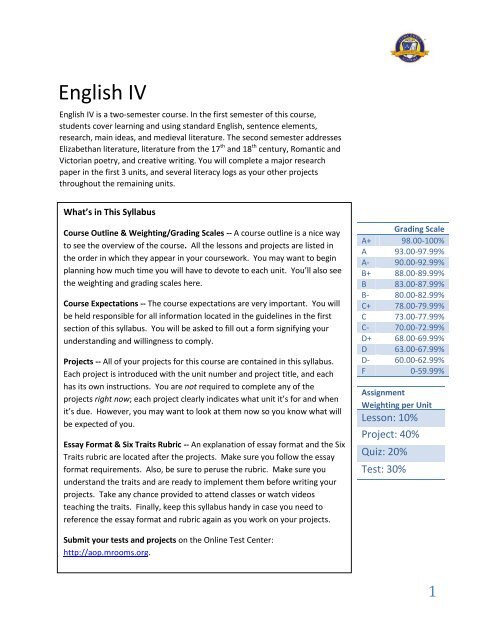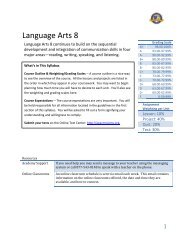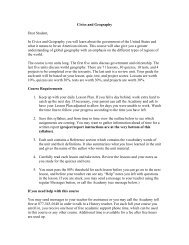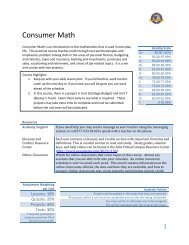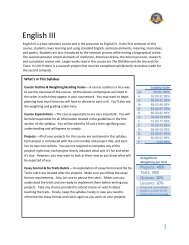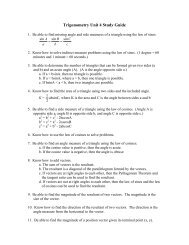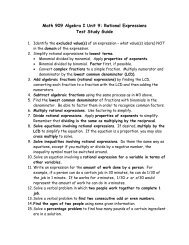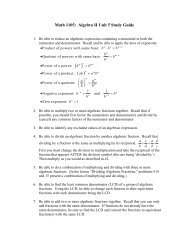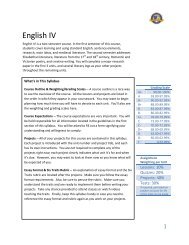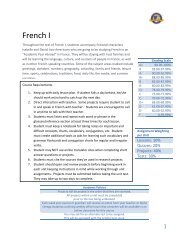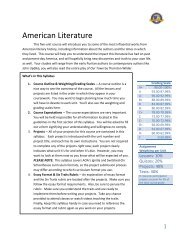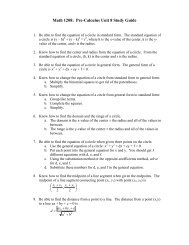Create successful ePaper yourself
Turn your PDF publications into a flip-book with our unique Google optimized e-Paper software.
<strong>English</strong> <strong>IV</strong><strong>English</strong> <strong>IV</strong> is a two-semester course. In the first semester of this course,students cover learning and using standard <strong>English</strong>, sentence elements,research, main ideas, and medieval literature. The second semester addressesElizabethan literature, literature from the 17 th and 18 th century, Romantic andVictorian poetry, and creative writing. You will complete a major researchpaper in the first 3 units, and several literacy logs as your other projectsthroughout the remaining units.What’s in This SyllabusCourse Outline & Weighting/Grading Scales -- A course outline is a nice wayto see the overview of the course. All the lessons and projects are listed inthe order in which they appear in your coursework. You may want to beginplanning how much time you will have to devote to each unit. You’ll also seethe weighting and grading scales here.Course Expectations -- The course expectations are very important. You willbe held responsible for all information located in the guidelines in the firstsection of this syllabus. You will be asked to fill out a form signifying yourunderstanding and willingness to comply.Projects -- All of your projects for this course are contained in this syllabus.Each project is introduced with the unit number and project title, and eachhas its own instructions. You are not required to complete any of theprojects right now; each project clearly indicates what unit it’s for and whenit’s due. However, you may want to look at them now so you know what willbe expected of you.Essay Format & Six Traits Rubric -- An explanation of essay format and the SixTraits rubric are located after the projects. Make sure you follow the essayformat requirements. Also, be sure to peruse the rubric. Make sure youunderstand the traits and are ready to implement them before writing yourprojects. Take any chance provided to attend classes or watch videosteaching the traits. Finally, keep this syllabus handy in case you need toreference the essay format and rubric again as you work on your projects.Grading ScaleA+ 98.00-100%A 93.00-97.99%A- 90.00-92.99%B+ 88.00-89.99%B 83.00-87.99%B- 80.00-82.99%C+ 78.00-79.99%C 73.00-77.99%C- 70.00-72.99%D+ 68.00-69.99%D 63.00-67.99%D- 60.00-62.99%F 0-59.99%AssignmentWeighting per UnitLesson: 10%Project: 40%Quiz: 20%Test: 30%Submit your tests and projects on the Online Test Center:http://aop.mrooms.org.1
Self tests/quizzes and tests: Self tests/quizzes and tests are closed book; no study materials, notes, or any other informationare allowed during the assessment.Think about a student taking a quiz or test in a brick and mortar school building. Once a studentsits down to take a quiz or test, he/she is not allowed to move until after handing in that quiz ortest. In the same way, you need to be serious and conscientious about your time andsurroundings when you take a quiz or test for your AOA schoolwork.o Do not open tests until you are ready and have studied thoroughly.o Do not open a test if you do not have sufficient time to dedicate to finishing it. Testsshould be taken in one sitting; do not exit the test or leave it before finishing it. If youleave the test open for too long, it will automatically close, and it will be graded as is.You will not be able to finish your test or change any answers.Self tests/quizzes- Self tests and quizzes are comprehensive; the student may be tested on any materialcovered thus far in that unit.Tests- Tests may cover everything in your unit. You will have only once chance to complete a test,so be sure you are prepared before taking it.- Alternate tests may be taken if you desire. Please contact the <strong>Academy</strong> if you would like totake an alternate test. (The two test scores will be averaged together.)Projects: Project expectations: Essays and assignments must be the student’s original creations,generated single-handedly by the student. Work may not have been submitted previously for agrade at <strong>Alpha</strong> <strong>Omega</strong> <strong>Academy</strong>, or any other school. No plagiarized, incoherent, incomplete, ordistasteful assignment will be accepted. Similarly, assignments may not mention, or refer to, anyoffensive, violent, illegal, disparaging or inappropriate language (including, but not limited to,words that are widely considered offensive to individuals of a certain race, ethnicity, or religion);promote the abuse of alcohol, illegal drugs, or tobacco ; or promote any activities that mayappear unsafe or dangerous.Assignments that violate these expectations may be reassigned to the student with a 20% gradededuction. Plagiarized work will be handled according to the <strong>Alpha</strong> <strong>Omega</strong> <strong>Academy</strong> plagiarismpolicy.Projects may be reassigned to the student for any of the following reasons:- The instructions were not followed completely.- MLA documentation is missing or incorrect.- The teacher requested changes be made to the project, and the student resubmittedthe work without making the requested changes.6
- Some projects will be part of a multi-step process (For example – writing a thesisstatement and an outline for a five paragraph essay, finding your sources for a researchpaper, etc.). Projects which are part of a multiple-step process should be submitted oneat a time and in the given order. Not being submitted as such may result in a gradededuction.If a project has been reassigned for any of the above reasons, it may receive a 20% gradededuction.Projects are 40% of your unit grade; it is very important to do your best on them.Projects are not optional. Every project must be completed to the satisfaction of the teacher.The formatting of your projects is important and it counts toward your grade. Projects must besubmitted with heading information – which includes your name, the date, your teacher’s name,and the class in the upper left corner of the first page of your assignment. See below for moreinformation on how to format your projects.When you first start each unit, read through all the directions for any projects in that unit sothat you will be prepared to complete them.Projects are not meant to be completed in a matter of minutes. Work on them as you workthrough your unit, being careful to follow all directions.Written projects may take longer to grade than lessons or tests. Be assured that your teacherswill grade your work as soon as possible. Projects will be graded in the order in which they arereceived.After your project has been graded, go back to the file you uploaded to look for your teacher’sfeedback. This feedback is very important for improving your writing skills and doing better onyour next project. If you do not know how to access the graded file, please call the language artsdepartment.Academic Support: You can find your teacher’s schedule for when they are available in their online office hoursusing the Gradebook on your DashboardStudents are encouraged to get academic support by contacting their teachers when they needassistance on their lessons.Be specific in your correspondence and communication with your teacher. (“I need help” is notspecific.) The better your teacher understands your problem, the quicker he or she will be ableto help you.Be polite and scholarly in your correspondence and communication with your teacher. Useproper spelling, grammar, and punctuation in all of your academic dealings with your teachers.Texting abbreviations or spellings are not acceptable or appropriate.Any message or email that you send to your teacher is expected to have a greeting (“Dear Mr. orMs. [Teacher’s last name]”) and signed with your name.Teachers cannot help students during tests and quizzes, although they can clarify what aquestion is asking if you are confused.7
1201 Project: Narrowing IdeasOver the next 3 units, you will be writing a 2,000-word research paper (about 4 pages). Be sureyou choose a topic that is specific, interesting, and worth writing on for a semester.Here are your goals for this project:Pick a topic for your research essay and write an expository paragraph on why you havechosen this topic.Find sources and take notes for your paperWrite your thesis statementPart 1: BrainstormingStep 1: Think about your interests, things you would like to know more about, or an interestingquestion you would like to examine. Examples might be “Should pet breeders be regulated?”,“the relationship between Canada and the United States,” “finding truth in secular music,” or, “isreading actually good for you?” These are all examples of topics, not thesis statements. You maypick any topic that you like; it just needs to be a question to answer, something to prove, orsomething to evaluate.Your essay may not be a report; you will need to find something to prove or evaluate about yourtopic.Step 2: Review the principles taught in the lessons "Expository Writing" and "ParagraphStructure."Step 3: Write an expository paragraph that tells what topic you have chosen, why it is interestingto you, and why you want to write about it. Format your writing like the example shown below.Step 4: Proofread your paragraph. Your paragraph should:o have a topic sentence with a controlling ideao explain and support your topic sentenceo be of appropriate length (your paragraph should be 150-200 words in length)o be free from typing errors, grammatical errors, misspellings, and punctuation errorsPlease write your paragraph in the space below these instructions.Here is an example of this assignment:8
My Research Essay Topic: The Benefits of ChocolateI have chosen to write my research paper on the benefits of chocolate. I know dark chocolatehas antioxidants, so I want to research how the antioxidants work and why they are good forthe human body. I’m not sure about the calories in the chocolate; eating food high in caloriesfrom sugar is not healthy, so I am interested to see how these two things work together andwhether or not chocolate really is a beneficial food to eat. Because of these reasons, I aminterested in writing about the health benefits of chocolate and I believe I could both learnfrom and enjoy writing my research paper on this topic.Write your paragraph here:Part Two: ResearchFor this part of the project, you will start your preliminary research. This means that you aredoing the first stages of research that will help you to know enough about your topic to write agood thesis statement. Find 8 sources on your topic. You may not use Wikipedia, Ask.com,Answers.com, or anything else that is not “scholarly”; it must be written by a professional in thefield that you are researching. Click here for a rubric to help you evaluate your sources.Published books are great ways to find scholarly sources. Authors of books are almost alwayseducated on their topic and qualified to give information. The best way to find books on yourtopic would be to go to your local library and ask the librarian to show you the correct section.You should also ask your librarian if your library has any scholarly journals, or access to onlinejournal databases, such as JSTOR or Ebscohost. A journal is like a magazine, but is written andedited by experts in that field.Step 1: Go to your library and find at least 4 books or journal articles on your topic. At least 4 ofyour sources must be published, hardcopy books or articles. This is not an optional part of theproject. If there is a legitimate reason that you cannot complete this step, you must contact yourteacher and ask for special permission to skip it. Make sure to explain why you need to beexcused.Step 2: If you did not pick 8 hardcopy sources, you should find the rest online. Online journalsare great places to look. Most major fields of study have an online journal, and an organization’swebsite (such as those hosted by National Geographic or the American Cancer Society) is also agood source for articles on your topic. Use the rubric from earlier to find good sources. GoogleScholar and Sweet Search are also excellent ways to find great sources.Step 3: List your 8 sources below. Follow the MLA format for citing sources. If it is a website,include the link so your teacher can view the source.9
Step 4: Read your sources and take notes on the ideas that apply to your topic. Copy downquotes, important information, and your thoughts as you read. Take special note of debatedissues. Be sure to include important page numbers so you can find the information later. Includethe most important fact, quote, or idea you learned from each source. It is essential that you letyour sources direct your thinking. Do not just go looking for sources that support what youalready think, find good sources and let that information be the basis for your paper.List your sources below:Part Three: Thesis StatementNow that you have your topic and sources, you will write your paper’s thesis statement.Remember, a thesis statement evaluates or proves something.“The benefits of chocolate” is just a topic, but “When eaten in moderate amounts, dark chocolatecan be a beneficial part of a healthy diet” is a thesis statement. It tells us that the essay will provethat dark chocolate is beneficial under certain circumstances.Keep in mind that your thesis statement must be a complex idea worth proving orevaluating. Any thesis statement that just reports on a subject will not be accepted.Step 1: Decide on your final idea for your thesis statement by choosing one thing to prove or evaluateabout your topic. Use the following resources to refine your understanding of thesis statements. If any ofthese links do not work, please notify the Language Arts Department.http://www.indiana.edu/~wts/pamphlets/thesis_statement.shtmlhttp://owl.english.purdue.edu/owl/resource/545/01/http://www.unc.edu/depts/wcweb/handouts/thesis.htmlStep 2: Create your thesis statement, making sure that it is specific, complex, and strong. Yournotes from the previous activity will help you greatly with this step. What stands out from yourresearch? What could you explain to your readers, and how will it benefit them? What pointcould you try to prove in your writing, or what question could your paper answer?Step 3: Below your thesis statement, write a properly-formatted paragraph (at least 5 sentences)explaining why your thesis statement meets the requirements given in the links above. Be aware thatany thesis deemed insufficient by your teacher will be reassigned without the standard 20%deduction.Write your thesis statement and paragraph here:10
1202 Research Paper Project: OutlinePart 1Narrow your sources for your research essay down to 5 or 6 sources that support yourapproved thesis statement. Write a paragraph for each source explaining why you kept thissource and how it supports your thesis statement.Step 1: Review your teacher’s comments on the Narrowing Ideas project, and review your research andyour notes on the sources you found.Step 2: Choose at least 5 of your 8 sources to keep as your final sources for your research essay. Choosethe ones that best support your thesis statement and list those sources in this file, formatted in MLA likeyou would for your works cited page. If you need to replace any of your sources now that you haveformed your thesis statement, you may. However, the new sources must also be scholarly.Step 3: List your sources in MLA format below your thesis. Write a paragraph for each source, explaining1) why you kept that source, 2) how it specifically supports your thesis statement, and 3) what itadds to your essay. Don’t just summarize the source.You may use KnightCite or NoodleTools for help making your works cited citations. These siteswill walk you through the citation process.Remember to alphabetize the list once you are done; go by the first word in the citation.Sometimes that will be the author’s last name, and sometimes that will be the first word from thesource’s title (if the title begins with “a” or “the,” put this word at the end and alphabetize by thesecond word). Replace the text below with your writing.Begin with your first source here…Write your title here…Write your thesis statement here.Part 2Create a detailed outline for your research essay. Include your title and thesis statement.Step 1: Create a title for your essay, and include your name, the teacher’s name, the class, and the date inthe left corner of the page above your title. Your title should not be “Research Essay” or just a restatement11
of your topic. Develop an informative and creative title that gives us some idea of the direction of theessay. Write your thesis statement below the title, as shown below.Step 2: Develop your main points and sub points and form them into an outline. You will need at least 3supporting points, and each main point should have 2-3 sub-points. Each sub-point needs to explainand expand on the supporting point it is grouped under. Remember that your main points must explainand prove your thesis statement; if they don’t, your project will be reassigned and 20% will be deductedas explained in the course expectations document.Use the following format to write your outline. Remember that the more detail you have in youroutline, the more direction and confidence you will have as you write. Follow the indications forArabic and Roman numerals:Jill StudentMrs. Smith<strong>English</strong> <strong>IV</strong>3-20-2011Chocolate: Guilty Pleasure or Healthy Snack?Thesis statement: Because it is high in calories from sugar and fat, white and milk chocolate can have anegative impact on bodily health; however, the antioxidants and lower fat levels in dark chocolate make ita beneficial food when eaten in moderate amounts.I. White and milk chocolate are not healthy1. high in calories2. high in fat3. high in sugarII. Dark chocolate is a healthy food(continue this format for the rest of your outline.)For tips on creating a useful outline seehttp://owl.english.purdue.edu/owl/resource/544/1/.Step 3: Place the sources you have chosen after the outline under the heading “Works Cited.” Make surethey are in proper MLA format.Step 4: Review your outline, looking for errors in logic, angles of your thesis statement that you did notdiscuss, and possible questions that you would need to answer in your essay. Make sure all the sub-pointssupport your main points, and that your main points support your thesis statement.Step 5: Proofread your outline for typing errors, spelling errors, and misplaced or missing punctuation.12
<strong>English</strong> 1203 Research Paper: Rough DraftMake sure that you do not start this project until you have received feedback on your Outliningproject from the previous unit. You will need to use the feedback from your teacher in order towrite your rough draft.All written projects in this course are to be written using either Times New Roman 12 point orArial 12 point black font.Here are your goals for this project:Write a rough draft of your essay, aiming for 2,000 words.Edit your rough draft for smoothness and clarity.Format your essay according to MLA style.Part A: EssayBefore you begin writing, be sure you review your teacher’s comments on your Outliningproject. It is also strongly recommended that you re-read the following lessons in unit 1 on MLAformat: “Documentation,” “Works Cited,” “Parenthetical Citation,” and “DocumentationReview.”Then, using your approved outline as a guide, write your essay in the space below (the space willexpand as you type). Make sure to write an introduction that will grab your audience’s attentionand a conclusion that will sum up the main point and leave the audience with an interestingthought. Get as close to 2,000 words as you can without adding unnecessary content; if you goover the word count, make sure you do not have unnecessary information. Your teacher will helpyou to reach an appropriate word count for your final draft. To get your word count in MicrosoftWord, highlight the part of the text that you want counted. Your word count will appear in thebottom left corner of the window. In other word processors, first highlight the part of the text youwant counted, then find the “Word Count” option under the “Tools” menu.Write the draft of your research paper below.Part B: Revising Vs. ProofreadingYou’ve gotten all your ideas out of your head and onto paper. Now it’s time to revise andproofread your draft. What’s the difference between the two, you ask?Proofreading: Proofreading is the process of checking all the little details. You’ll look forgrammatical and conventional errors, as well as any formatting or layout issues. Proofreadingcovers spelling, punctuation, grammar, word choice, and complete sentences.13
When you are proofreading, you are making sure the reader does not stumble over your messagedue to conventional errors.Here’s a link that explains some common proofreading errors to look for in your essay:http://www.indiana.edu/~wts/pamphlets/proofing_grammar.shtml.Revising: Revising means to re-write and re-work your paper in a broader sense of organization,ideas, and meaning. When you revise, you will be making sure that your supporting points areclearly explained, your sentences are in logical order, and your ideas flow smoothly from onesentence to the next, and from one paragraph to the nextYou may remove sentences or information that is not required, and you may even need torestructure an entire paragraph or two if this would better convey the ideas to the reader.Essentially, when you are revising, you are making sure the reader will focus on your thesis,main points, and overall message of the essay.Now that you know what revising and proofreading are, take a break from your essay’s draft.Come back to your draft with fresh eyes. Read through your rough draft to see if your writingmakes sense; better yet, read it to another person. Does it show what you want your reader tounderstand? If not, make some notes and corrections directly on your rough draft on howyou can clarify and fix your writing for the final draft.You MUST proofread and revise your rough draft before submitting this project. If you donot, it will be apparent to your teacher that you skipped this step, and it will affect yourgrade.Part C: Looks MatterBecause this was a research paper, you must have works cited sources and parentheticalcitations. If you need help with these, feel free to use KnightCite or NoodleTools. You also needto format your essay’s general layout so it meets proper MLA format. Your teacher will check tomake sure your essay is actually formatted correctly. You should use the table to make sure thatyour paper is formatted correctly, though you do not need to fill it out.Here’s a good example research paper that follows proper MLA format, with the margins,double-spacing, header, title, etc.: http://www.aoacademy.com/media/kb/SampleResearchPaper.pdf.Correct?(yes/no)MLA Format Layout RequirementAll typed projects or essays in <strong>English</strong> are to be written using Times NewRoman 12-point or Arial 12-point black font.14
Margins should be 1 inch on both sides of your writing.Your writing needs to be double-spaced throughout the entire essay.Paragraphs need to be indented.Add a header with your name, then your teacher’s name, the class, and thedate in the top left corner, each on separate lines. These lines should also bedouble-spaced.Make sure that all works cited entries are correctly formatted andparenthetical citations are used correctly.Finally, include a title for your draft, centered and double-spaced right aboveyour introductory paragraph. Make your title creative, such as “Star of theHarlem Renaissance” (instead of the rather bland “Langston Hughes”).1204 Project: ConsultationYou must complete this project before you begin work on the final draft ofyour paper. Read carefully through the directions and complete exercises oneand two. Then submit this project, and meet with your teacher to discuss youranswers.A. Exercise One: Reviewing the Six Traits of WritingWatch the following overview videos on the Six+1 Traits. (Each video is less than five minutes.)Part I: http://www.screencast.com/t/CJlPiI6EPart II: http://www.screencast.com/t/PlhC8WQiOcPart III: http://www.screencast.com/t/1guOAEFlXbfdAnswer the following questions about the videos in the space provided.1. What three parts will be included in a paper with good Organization?2. Which trait deals with the rhythm and flow of the language in a paper?3. What does the trait of Presentation deal with?15
B. Exercise Two: Respond to FeedbackGo back to the graded copy of the first draft of your essay. Look at what your teachersaid about your draft and respond by answering the following questions. Spend sometime thinking about both your essay and the trait(s) your teacher has recommended forimprovement. Later, you will have a chance to talk to your teacher about that trait(s),ways to improve your essay, and any other questions you might have. Your answershould not be limited to the space provided. The space will expand as you give youranswer.1. What trait(s) did your teacher recommend for you to work on in this essay?2. What does a paper that is strong in this trait look like?3. Which weak areas have you found in your essay? Explain with specific examples.Why do you think this area is weak? Later, when you talk to your teacher, be readyto discuss these weaknesses.4. What are your ideas about how to make your paper stronger in this trait? List concreteideas.C. Exercise Three: Teacher ConsultationAfter you have submitted your responses to the questions above, you will be ready to talk to your teacherabout this project. Go to your teacher’s office hours to talk about your rough draft. Make sure to comeprepared to discuss what you have learned through this process and how you will improve yourproject.Teacher comments:1204 Research Paper Project: Final DraftIn this project use all of the work you have done in previous projects to write your final researchpaper.Here is your goal for this assignment:16
Write a final draft of your research paper.The purpose of this paper is to utilize the preparation that you have done in writing a thorough,cohesive paper that supports your thesis statement.Note: You must make any changes your teacher recommended on your project beforeturning it in. Projects that are identical to their “rough draft” forms will be reassigned witha 20% grade reduction.If your teacher did not recommend changes, you should still read through your paper tocatch any final weak spots.Instructions:Utilizing your rough draft and feedback from your teacher, write the final draft of your researchpaper, making sure that you follow your teacher’s recommendations. You will use MLAparenthetical documentation and a properly formatted works cited page. If necessary, refer to thedocumentation lessons from unit one.Editing and revising:The final research paper should be approximately 2000 words in length. To use the “wordcount” tool in a Microsoft Word document, highlight the text that you want to count. Theword count will appear in the bottom left corner of the window. In other word processors,first highlight the text that you want to count, then find the “Word Count” option underthe “Tools” menu.Projects that are more than 10% (200 words) off of this word count will suffer a gradereduction at your teacher’s discretion.Revise your paper in order to achieve the most effective wording and transitions, as wellas for correct spelling and mechanics. If possible, have someone read your work andsuggest changes and/or corrections. Reading it out loud can also be very helpful.Start your paper on the next page.1205 Project: BeowulfHere are your goals for this project:1. Watch the dramatic presentation of a section of Beowulf as performed by JulianGlover before you read the lesson:http://www.youtube.com/watch?v=IR464WBmA2s17
2. Watch the documentary Beowulf and the Anglo-Saxons written by Peter MorganJonesStep 1: The documentary can be ordered from Amazon.com, or watch it in sections onYouTube. It is about an hour long. As you watch the documentary, take notes on importantpoints, good quotes, or interesting information. If any of these links do not work, please notifythe Language Arts Department.Amazon: http://www.amazon.com/Beowulf-Anglo-Saxons-Artist-Not-Provided/dp/B000LC3IWE/ref=sr_1_1?s=dvd&ie=UTF8&qid=1303325079&sr=1-1YouTube, sections 1-8:http://www.youtube.com/watch?v=R3hjjaUQiVAhttp://www.youtube.com/watch?v=QhKBY5WgECYhttp://www.youtube.com/watch?v=a3aHMj4X08Yhttp://www.youtube.com/watch?v=i1cAME01lX0http://www.youtube.com/watch?v=ZisY7tBjHOIhttp://www.youtube.com/watch?v=38On_Wvg9CQhttp://www.youtube.com/watch?v=sL-ZLVk0f5Ahttp://www.youtube.com/watch?v=cu6OXsyJghkStep 2: Write your reaction to the Julian Glover presentation of Beowulf. Did it bring the epic tolife for you? Did it make it easier to understand? (50 – 100 words)Step 3: Explain how Anglo-Saxon Ruins from Bury St. Edmunds and Sutton Hoo havecontributed to the understanding of both Anglo-Saxon culture and the epic Beowulf. (100 words)Step 4: How did J.R.R. Tolkien’s essay help historians, archaeologists, and literary scholarsunderstand the Anglo-Saxon period and the Beowulf epic? (100 words)Step 5: Sketch out an Anglo-Saxon village with the Great Hall and the homes surrounding it.Write a paragraph explaining your picture and the significance of the Great Hall in Anglo-Saxonculture. ( 50 – 100 words) (If you have a problem uploading your sketch, contact your teacherabout emailing it.)Submit the project after ALL steps have been completed.1206 Project: HamletThis project will be completed after you finish reading the play. Read through this project beforereading the play so that you can be thinking about what option you will choose and how you willcomplete that option.18
Here is your goal for this project:Option A: Interpret and explore a theme from Hamlet in a visual essay.Option B: Cast Hamlet with modern actors.Option A:Visual EssayA visual essay is a video that expresses ideas through text, images, and sounds. Ideas presentedvisually are very effective ways of communicating with an audience. Unity between images,sound, and ideas is very important when creating a visual essay.To create your visual essay, first make sure you have access to Movie Maker, iMovie, orFreeDV. Familiarize yourself with using it through the “help” topics, tutorials, or anything elseyou need to do in order to be able to use it competently.Next, form your idea for your visual essay. You need an argument or a question as the main idea.This main idea, your thesis statement, will guide the organization of your project. Organizationhere is very, very important; visual essays are not just images set to music. Much like in poetry,the images, text, and music must all communicate complex ideas that explore and support yourmain idea. Watch the visual essay below, and think about how it presents its ideas.This video does a good job of using images to carry the bulk of the meaning. The photo of thefamily expresses the “ideal life” without having to state it in text, and the fallen chess piecesymbolizes King Hamlet’s death. The video does have a lot of words in it, and fewer wordsprobably could have been used. Still, the images express the ideas. Notice particularly how thisvideo uses quotes from Hamlet. The quotes appear, and the image explains them. Try to do thisin your visual essay. http://www.youtube.com/watch?v=0jmPeOP5UIEAfter you have your main idea (Horatio’s loyalty to Hamlet, Ophelia’s treatment by the men,Claudius’s regret at not being able to give up the crown and queen, etc), form your ideas aboutwhat you want to convey to your audience about this idea. You may want to write down anoutline to help you organize your thoughts; your goal is not simply pictures set to music withquotes from the play, it is to produce a symbolic journey through an experience, explore an idea,or provide resolution to a question.Once you know what you want to convey about your main idea, think about how you willrepresent those ideas. Just like in poetry, a visual essay relies heavily on symbolism and images.Find those pictures that are worth a thousand words! You may use still shots from the Hamletmovies, illustrations of the play, and any image that can effectively represent your ideas. Use textsparingly; be wary of using sentences. Aim for just quotes from the play and one- or two- wordphrases, and try to use those symbolically as well. You may review poetic devices here:http://www.chaparralpoets.org/devices.pdf. The devices of imagery, metaphor, metonymy,19
epetition, and allusion may be particularly helpful to you. Try to match font, color, music, speedof the effects, and the effects themselves to your ideas. These things are great ways to refine thetone and mood. Don’t forget to title your video.Once you have completed this, upload your video to YouTube. You should talk with yourparents about creating an account safely before doing this. Once you have the link to your video,copy and paste the link on the last page of this document. Include your name, the date, the class,your teacher’s name, and the title in the heading above the link. Below the link, write at least150 words explaining your choice of music, your main idea, and how you use images tosupport that idea. Proofread your paragraph before turning it in to be graded.Option B: Casting the PlayImagine that you have been chosen to direct the play Hamlet. As director, it is your privilege tofill the roles. For each main character in the play and several of the minor characters, you willchoose an actor to fill the role. You will then explain how previous roles in movies or showshave prepared the individual to fill this role. Be very specific so that your teacher can not onlytell that you have read and understood Hamlet, but also that you know your cast very well.You can also choose to fill your cast with characters from a book, movie, or TV show that youhave read or seen. In that case, you will use the experiences of that character in the book, movieor show to demonstrate how he/she is prepared to fill the role. Again, be very specific so thatyour teacher can not only tell that you have read and understood Hamlet, but also that you knowyour cast very well.For each of the main characters, write a brief paragraph (about 90 words) telling who will playthe role and why that actor or character is qualified. For each of the supporting characters, writea shorter paragraph (about 75 words). Pick any two of the minor characters and write oneparagraph about the two of them (about 60 words).Main characters: Hamlet, Claudius, GertrudeSupporting roles: Polonius, Horatio, Ophelia, LaertesMinor characters: Fortinbras, the ghost, Rosencrantz and Guildenstern20
1207 SWIFT AND GOLDSMITHThe purpose of this project is for you to write an essay based on the examination of the works ofJonathan Swift and Oliver Goldsmith. You are to demonstrate an understanding of their satire, inorder to see similarities and/or differences.Here is your goal for this assignment:Compare and contrast the social criticism of Goldsmith and Swift to today's issues.Using at least two current newspapers, news magazines, or television news programs, researchcurrent political and/or social issues in the U.S. or the world. Choose three or four issues to focuson. The editorial or opinion sections should be especially helpful. Compare the things eitherSwift or Goldsmith, or both Swift and Goldsmith, found that needed changing in their centuriesto today's issues. What similar issues do we face today?Write an essay (at least 500 words) that compares the issues of these two different times. Includeyour personal perspective on the issues and solutions offered for today's issues. Are they reallyissues that need attention as far as you are concerned? Are the solutions offered valid as far asyou are concerned?Organize your notes and create an outline Utilizing your outline and notes, write the first draft ofyour essay, making sure that you follow your outline. You must use MLA parenthetical citationsand include a works cited list to cite your sources. (If necessary, refer to the MLA format sitesavailable in the Reference of this unit.) Revise your first draft and submit the completed essay.Your outline need not be submitted for grading.Your essay will be graded based on the following:your attention to the instructions given abovethorough, detailed comparison and contrast of the works of Swift and Goldsmithreasonable development and analysis to support your thesis statementcorrect MLA parenthetical citation and works cited formatuse of proper punctuation, spelling, grammar, and sentence construction (commonlycalled "conventions"), and appropriate lengthThis project will be graded based on the depth and clarity of your answers.Type your essay below:21
1208 Novel ProjectStart this project at the beginning of your unit and work through it as you do your lessons.This project requires you to find a book, so read through the file to see your options. Pleasecomplete each of the steps below thoroughly and thoughtfully. If you need help with any of theseconcepts, please call the language department.Choose a bookChoose a novel from the list below. Once you have made your choice, you may purchase it,borrow it from a friend, or check it out from a library. Some of the choices may be downloadedand read online or on a Kindle from Project Gutenberg (links provided).A Tale of Two Cities by Charles Dickens: http://www.gutenberg.org/ebooks/98Jane Eyre by Charlotte Bronte: http://www.gutenberg.org/ebooks/1260Dracula by Bram Stoker: http://www.gutenberg.org/ebooks/345Robinson Crusoe by Daniel Defoe: http://www.gutenberg.org/ebooks/521Emma by Jane Austen: http://www.gutenberg.org/ebooks/158Lord of the Rings by J.R.R. TolkienAnimal Farm by George OrwellRead the exercises below before starting the novel.Exercise One: Writing/Reading ComprehensionThis exercise blends reading comprehension skills with writing skills. Think back to all you havelearned this year about determining theme, finding truth in literature, understanding poeticdevices in prose, and connecting to what you read. This project will require you to show that youcan do all those things competently.As you read the book you chose, keep a reading journal. Make at least 10 entries. A readingjournal is much like a personal journal, except that the topics center around the book being read.Here is an example:22
Today I started reading A Wrinkle in Time by Madeleine L’Engle. So far,I’m enjoying Meg. It’s nice to see a girl who is obstinate and a trouble-maker atschool as a main character, instead of the passive “nice girl” stereotype. Her flawsare ones many people have, and even though she can be argumentative, she lovesCharles Wallace so much that she’s still a positive character. One thing I amenjoying is seeing Meg’s relationships with her parents. She clearly is frustratedand scared by her father’s absence, and the way she looks up to her mother makesme think Meg will turn out well in the end.Your entries may be informal, but they should be deep. Explore the characters, themes, setting,voice, tone, plot, etc., and reflect on them. You may mention things in real life that they remindyou of, compare a character to someone you know, discuss any relevant news relating to thesetting you have heard, discuss the writing devices used by the author, or react to the ideas in thenovel. You’ll be graded on the neatness and depth of your answer- whether or not you personallyreact to and process the text. A good idea for your first entry is to discuss why you chose thisnovel to read.Write each of your 10 entries below. Each entry should be no less than 100 words. As with allassignments, include a heading and title, and double-space your writing. List the date of thejournal entry above each one.Journal:Exercise Two: Media ParticipationCreate a poster, digital or physical, that explores the themes of the novel you read for thisproject. You may use photos from the film (if one exists), symbolic images, video clips, music,quotes from the book, and color to communicate your ideas, but you don’t have to use all ofthose. Make sure the images are balanced, and all components work together to create a cohesiveexperience of the novel rather than simply being pieces existing near each other. Each one mustadd to the whole and not distract from the other elements. You may use text, but it must beminimal. It should either be important thematic quotes from the novel or else explain elements ofthe poster. Include the title of the novel on the poster.If you do a digital poster, you may use DoInk, Glogster, or any other online digital postercreator. Here are some good examples of digital posters on a book. They are heavy on text, souse less on your own poster. Do, however, include explanations of your major choices (likemusic) in the poster. Each choice in image, text, color, and video must be intentional and itshould be clear why you made that choice.23
http://kaitlinjadeee.edu.glogster.com/diary-of-anne-frank-5982/http://linwil20.edu.glogster.com/ba-4-hunger-games/This final example doesn’t explore the story much at all, but the layout and the variety of itemsused is excellent. http://ctg115.edu.glogster.com/rikki-tikki-tavi-characters/Browsing Glogster to see more examples and to see what is possible is advisable. You may alsodo tutorials to develop your skills and learn how to use Glogster.If you do a physical poster, take a very clear photo of your poster, save it to your computer, andemail the photo to your teacher. Be sure to explain what it is that you are emailing.Link, image, or explanation of method used to get the poster to your teacher:1209 PROJECT: JOURNALKeeping a journal can help put you in a story-writing mentality. By writing down events andfeelings, you can articulate ideas and develop your writing style.Here is your goal for this assignment:Keep a personal journal of life events and story ideasUsing your word processor, begin a journal and continue to write in it daily until you finish thissection. Write down everything you participate in or observe that might be of interest in a shortstory.Start your journal below:[Date of your first entry]Entry begins here…1209 PROJECT: WRITING DESCRIPTIONSYou have learned that writing detailed descriptions is essential to establishing the setting of ashort story.24
Here is your goal for this assignment:Write short descriptionsGuided by the information given in Lesson 3, write a brief one-paragraph-description (at least sixsentences in length) of each of the following items. Observe each item carefully beforedescribing it. Try to use at least one metaphor per item.a. a shabby sofa, yard, or vehicleb. a building or a parkc. an animald. a childType your paragraphs below. The space will expand as you type.a.b.c.d.Essay Format RequirementsAs a reminder, all typed work in <strong>English</strong> I must adhere to these format requirements as stated inthe Language Arts Course Expectations agreement (unless specifically stated otherwise in aproject’s directions or by your teacher):‣ Margins of the page should be one inch on all sides.25
‣ Typed projects must be written using Times New Roman 12-point font or Arial 12-point font.‣ Font must be black in color.‣ Typed projects must be double-spaced, including the title.‣ Header: Your name, the teacher’s name, the class and assignment, and the date shouldbe the first thing to appear on the page. These should be listed in that order in the upperleft corner of the page.‣ Title: Title your paper appropriately and center the title in the middle of the page.‣ Start your writing after the title. Writing should always be aligned with the left side ofthe page (unless you are indenting the first line). Writing should never be centered likethe title.‣ All new paragraphs must be indented by hitting the “Tab” button on your keyboard, orby pressing the spacebar five times.‣ If MLA format is required for the project, all sources and parenthetical citations must bewritten in the most current version of MLA format.Any typed work that does not meet these requirements could be deducted points and couldreduce your overall grade for that work.Six+1 Traits RubricSome of your projects in <strong>English</strong> I will be graded according to the Six+1 Traits Rubric. If acertain trait is not applicable to the project type, the teacher will not provide a grade for that traitand it will not be factored into your final grade.Trait 5 3 1This paper is clear and focused. Itholds the reader’s attention.Relevant anecdotes and detailsenrich the central theme.The writer is beginning to definethe topic, even thoughdevelopment is still basic orgeneral.The paper has no clear sense ofpurpose or central theme. Thereader must make inferences basedon sketchy or missing details.Ideas: Themain messageof the piece,the theme,withsupportingdetails thatenrich anddevelop thattheme.1. The topic is narrow andmanageable.2. Relevant, telling, quality detailsgo beyond the obvious.3. Ideas are crystal clear andsupported with details.4. Writing from knowledge orexperience; ideas are fresh andoriginal.5. Reader’s questions areanticipated and answered.6. Insightful topic.1. The topic is broad.2. Support is attempted.3. Ideas are reasonably clear.4. Writer has difficulty going fromgeneral observations about topicto specifics.5. The reader is left withquestions.6. The writer generally stays ontopic.1. The writer is still in search of atopic.2. Information is limited or unclearor the length is not adequate fordevelopment.3. The idea is a simple restatementor a simple answer to the question.4. The writer has not begun todefine the topic.5. Everything seems as important aseverything else.6. The topic may be repetitious,disconnected, and containing toomany random thoughts.26
Organization:The internalstructure,thread ofcentralmeaning,logical, andsometimesintriguingpattern orsequence ofideas.Voice: Theuniqueperspective ofthe writerevident in thepiece throughthe use ofcompellingideas,engaginglanguage, andrevealingdetails.Word Choice:The use ofrich, colorful,and preciselanguage thatmoves andenlightens thereader.The organizational structure of thispaper enhances and showcases thecentral idea or theme of the paper;includes a catchy introduction anda satisfying conclusion.1. An inviting introduction drawsthe reader in; a satisfyingconclusion leaves the reader with asense of closure and resolution.2. Thoughtful transitions connectideas.3. Sequencing is logical andeffective.4. Pacing is well-controlled.5. The title, if desired, is original.6. Organizational structure isappropriate for purpose/audience;paragraphing is effective.The writer of this paper speaksdirectly to the reader in a mannerthat is individual, compelling,engaging, and respectful for theaudience.1. Uses topic, details, and languageto strongly connect with theaudience.2. Purpose is reflected by contentand arrangement of ideas.3. The writer takes a risk withrevealing details.4. Expository or persuasive writingreflects understanding andcommitment to topic.5. Narrative writing is honest,personal, and engaging.Words convey the intendedmessage in a precise, interesting,and natural way.1. Words are specific and accurate.2. Striking words and phrasescreate imagery.3. Natural, effective, andappropriate language.4. Lively verbs, specific nouns, andmodifiers.5. Language enhances and clarifiesmeaning.6. Precision is obvious by choice ofwords and phrases.The organizational structure isstrong enough to move the readerthrough the text without too muchconfusion.1. The paper has a recognizableintroduction and conclusion.2. Transitions sometimes work.3. Sequencing shows some logic,yet structure takes attention awayfrom the content.4. Pacing is fairly well-controlled.5. A title, if desired, is present.6. Organizational structuresometimes supports the main pointor story line, with an attempt atparagraphing.The writer seems sincere, but notfully engaged or involved. Theresult is pleasant or evenpersonable, but not compelling.1. Attempt to connect withaudience is earnest butimpersonal.2. Attempts to include content andarrangement of ideas to reflectpurpose.3. Occasionally reveals personaldetails, but avoids risk.4. Expository or persuasivewriting lacks consistentengagement with topic.5. Narrative writing reflectslimited individual perspective.The language is functional, even ifit lacks much energy.1. Words are adequate and correctin a general sense.2. Familiar words and phrasescommunicate.3. Attempts at colorful language.4. Passive verbs, everyday nouns,mundane modifiers.5. Language functions, with oneor two fine moments.6. Occasionally, the words andphrases show refinement andprecision.The writing lacks a clear sense ofdirection1. No real lead or conclusionpresent.2. Connections between ideas, ifpresent, are confusing.3. Sequencing needs work.4. Pacing feels awkward.5. No title is present (if requested).6. Problems with organizationalstructure make it hard for the readerto get a grip on the main point orstory line. Little or no evidence ofparagraphing present.The writer seems uninvolved withthe topic and the audience.1. Fails to connect with theaudience.2. Purpose is unclear.3. Writing is risk-free, with nosense of the writer.4. Expository or persuasive writingis mechanical, showing noengagement with the topic.5. Narrative writing lacksdevelopment of a point of view.The writer struggles with a limitedvocabulary.1. Words are nonspecific ordistracting.2. Many of the words don’t work.3. Language is used incorrectly.4. Limited vocabulary, misuse ofparts of speech.5. Language is unimaginative andlifeless.6. Jargon or clichés, persistentredundancy.27
SentenceFluency: Therhythm andflow of thelanguage, thesound of wordpatterns, theway in whichthe writingplays to theear, not just theeye.Conventions:Themechanicalcorrectness ofthe piece;spelling,punctuation,capitalization,grammarusage, andparagraphing.The writing has an easy flow,rhythm, and cadence. Sentencesare well-constructed.1. Sentences enhance the meaning.2. Sentences vary in length as wellas structure.3. Purposeful and varied sentencebeginnings.4. Creative and appropriateconnectives.5. The writing has cadence.The writer demonstrates a goodgrasp of standard writingconventions (e.g., spelling,punctuation, capitalization,grammar usage, paragraphing).1. Spelling is generally correct.2. Punctuation is accurate.3. Capitalization skills are present.4. Grammar and usage are correct.5. Paragraphing tends to be sound.6. The writer may manipulateand/or edit for stylistic effect; and itworks!The text hums along with a steadybeat, but tends to be morepleasant or businesslike thanmusical.1. Sentences get the job done in aroutine fashion.2. Sentences are usually of similarlength, yet constructed correctly.3. Sentence beginnings aresomewhat varied.4. The reader sometimes has tohunt for connective clues.5. Parts of the text inviteexpressive oral reading; otherparts may be stiff, awkward,choppy, or gangly.The writer shows reasonablecontrol over a limited range ofstandard writing conventions.1. Spelling is usually correct orreasonably phonetic on commonwords.2. End punctuation is usuallycorrect.3. Most capitalized words arecorrect.4. Problems with grammar andusage are not serious.5. Paragraphing is attempted.6. Moderate, inconsistent editing(a little of this, a little of that).The reader has to practice quite abit in order to give this paper a fairinterpretive reading.1. Sentences are choppy,incomplete, rambling, or awkward.Phrasing does not sound natural.2. No “sentence sense” is present.3. Sentences begin the same way.4. Endless connectives, if anypresent.5. Writing does not inviteexpressive oral reading.Errors in spelling, punctuation,capitalization, usage, and grammarand/or paragraphing repeatedlydistract the reader and make textdifficult to read.1. Spelling errors are frequent.2. Punctuation is missing orincorrect.3. Capitalization is random.4. Obvious grammar or usageerrors.5. Paragraphing is missing.6. Little, if any, editing; the readermust read once to decode, thenagain for meaning.Presentation:The look of thepaper, properuse of MLAformattingwhennecessary,correct titlingand inclusionof projectinstructionsThe project is clean, has alldirections included, and MLAformat was used correctly ifneeded.1. Project directions precede theproject.2. Spacing is uniform and font isTimes New Roman or Arial 12point.3. In a multimedia project, use ofvisuals is integrated withoutdistraction.4. Correctly formatted citations andworks cited if outside sources wereused.May be some problems in theformatting.1. Project directions are included,but not placed correctly.2. There are some problems withfont or spacing.3. For multimedia, the visuals aresomewhat unclear or distracting.4. In those projects for whichoutside sources were used, MLAformatting is mostly correct.There may be some componentsmissing or improperly formatted.Errors in formatting create aconfusing paper that distracts thereader.1. Project directions are missing orincomplete.2. Spacing and font are notstandard.3. Visuals in a multimedia projectare confusing and substandard.4. Works cited page and/orparenthetical citations for thoseprojects where necessary aremissing or incorrect.*0 – Not a valid attempt. Student did not make the changes recommended by the teacher.28


